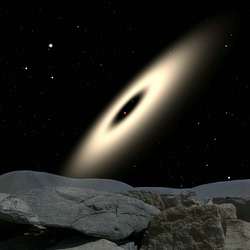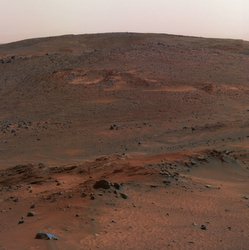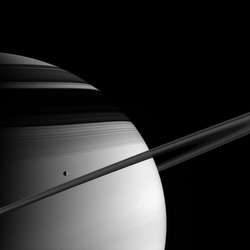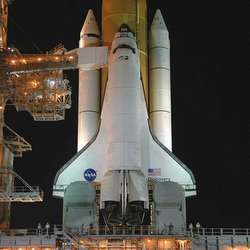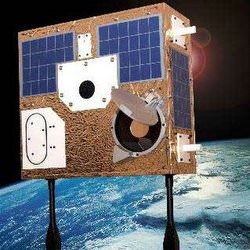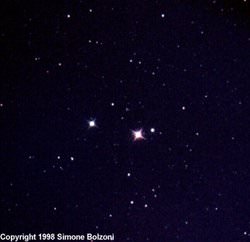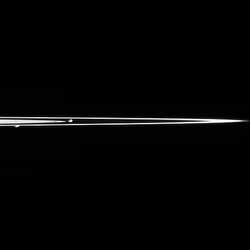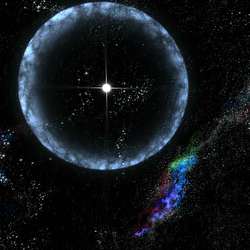
Artist?s conception of the gamma ray flare expanding from SGR 1806-20. Image credit: NASA.Click to enlarge
A gigantic explosion on a neutron star halfway across the Milky Way galaxy, the largest such explosion ever recorded in the universe, should allow astronomers for the first time to probe the interiors of these mysterious stellar objects.
An international team of astrophysicists, combing through data from a NASA X-ray satellite, the Rossi X-ray Timing Explorer, reports in the July 20th issue of Astrophysical Journal Letters that the explosion produced vibrations within the star, like a ringing bell, that generated rapid fluctuations in the X-ray radiation it emitted into space. These X-ray pulses, emitted during each seven second rotation by the fast-spinning star, contained the frequency vibrations of the neutron star?s massive quakes.
Much as geologists probe the Earth?s interior from seismic waves produced by earthquakes and solar astronomers study the sun using shock waves traveling through the sun, the X-ray fluctuations discovered from this explosion should provide critical information about the internal structure of neutron stars.
?This explosion was akin to hitting the neutron star with a gigantic hammer, causing it to ring like a bell,? said Richard Rothschild, an astrophysicist at the University of California?s Center for Astrophysics and Space Sciences and one of the authors of the journal report. ?Now the question is, What does the frequency of the neutron star?s oscillations?the tone produced by the ringing bell?mean?
?Does it mean neutron stars are just a bunch of neutrons packed together? Or do neutron stars have exotic particles, like quarks, at their centers as many scientists believe? And how does the crust of a neutron star float on top of its superfluid core? This is a rare opportunity for astrophysicists to study the interior of a neutron star, because we finally have some data theoreticians can chew on. Hopefully, they?ll be able to tell us what this all means.?
The biggest star quakes ripped through the neutron star at an incredible speed, vibrating the star at 94.5 cycles per second. ?This is near the frequency of the 22nd key of a piano, F sharp,? said Tomaso Belloni, an Italian member of the team who measured the signals.
The international team?led by GianLuca Israel, Luigi Stella and Belloni of Italy?s National Institute of Astrophysics?discovered the oscillations from data it retrieved two days after Christmas by the Rossi X-Ray Timing Explorer, a satellite designed to study the fluctuating X-ray emissions from stellar sources. The peculiar oscillations the researchers found began three minutes after a titanic explosion on a neutron star that, for only a tenth of a second, released more energy than the sun emits in 150,000 years. The oscillations then gradually receded after about 10 minutes.
Neutron stars are the dense, rapidly spinning cores of matter that result from the crushing collapse of a star that has depleted all of its nuclear fuel and exploded in a cataclysmic event known as a supernova. The collapse is so crushing that electrons are forced into the atomic nucleus and combine with protons to become neutrons. The resulting sphere of neutrons is so dense?packing the mass of the sun in a sphere only 10 miles in diameter?that a spoonful of its matter would weigh billions of tons on Earth.
Most of the millions of neutron stars in our Milky Way galaxy produce magnetic fields that are a trillion times stronger than those of the Earth. But astrophysicists have discovered less than a dozen ultra-high magnetic neutron stars, called ?magnetars,? with magnetic fields a thousand times greater?strong enough to strip information from a credit card at a distance halfway to the moon.
These intense magnetic fields are strong enough they sometimes buckle the crust of neutron stars, causing ?star quakes? that result in the release of gamma rays, a more energetic form of radiation than X-rays. Four of these magnetars are known to do just that and are termed ?soft gamma repeaters,? or SGRS, by astrophysicists because they flare up randomly and release a series of brief bursts of gamma rays.
SGR 1806-20, the formal designation of the neutron star that exploded and sent X-rays flooding through the galaxy on December 27, 2004?producing a flash brighter than anything ever detected beyond the solar system?is one of them. The flash was so bright that it blinded all X-ray satellites in space for an instant and lit up the Earth?s upper atmosphere.
Astrophysicists suspect the burst of gamma-ray and X-ray radiation from this unusually large explosion could have come from a highly twisted magnetic field surrounding the neutron star that suddenly snapped, creating a titanic quake on the neutron star.
?The scenario was probably analogous to a twisted rubber band that finally broke and in the process released a tremendous amount of energy,? said Rothschild. ?With this energy release, the magnetic field surrounding the magnetar was presumably able to relax to a more stable configuration.?
The December 27 flash of energy was detected by several other NASA and European satellites and recorded by radio telescopes around the world. It already has been the subject of numerous scientific papers published in recent months.
?The sudden and surprising occurrence of this giant flare, which will help us learn more about the nature of magnetars and the internal make-up of neutron stars,? said Rothschild, ?underlines the importance of having satellites and telescopes with the capacity to record unusual and unpredictable phenomena in the universe.?
Other members of the international team were Pier Giorgio Casella, Simone Dall?Osso and Massimo Persic of Italy?s National Institute of Astrophysics; Yoel Rephaeli of UCSD and the University of Tel Aviv; Duane Gruber, formerly of UCSD and now at the Eureka Scientific Corporation in Oakland, Calif; and Nanda Rea of the National Institute for Space Research in the Netherlands.
Original Source: UCSD News Release
Here’s a link to the biggest stars in the Universe.

